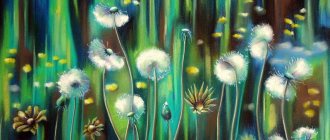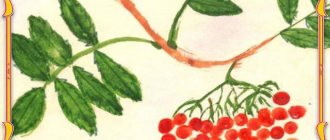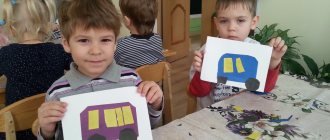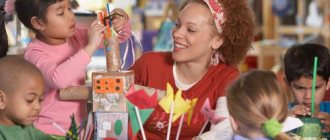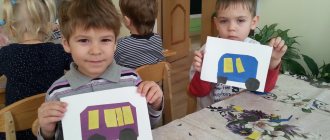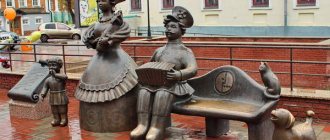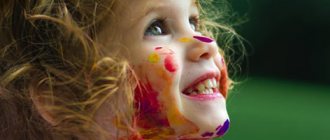Municipal preschool educational institution combined type kindergarten N 50 “Ogonyok” Moscow region, Dmitrovsky district, pos. Iksha, Middle group No. 7
Completed and prepared by Educator: Bondareva A.V. 2016-2017 academic year year
Goal: Learn to draw dandelion flowers using the poking method.
Task:
- strengthen children's ability to paint leaves with the tip of a brush
- expand children's knowledge about the first spring flowers.
- Enrich children's vocabulary and instill an interest in poetry.
Materials: green A-4 paper, yellow gouache, two brushes, hard and soft, napkins for each child, a water container, a picture of dandelions.
Preliminary work: Observing spring changes in wildlife. Looking at dandelions on a walk, reading the educational fairy tale “The Dandelion and the Wind”
.
Progress of the lesson: Guys, come in, hello guys. Look, we have guests. Let's say hello
.
Educator: What time of year is it now?
Children: Spring.
Educator: By what signs did you know that it is spring? (the sun is shining warmer, the birds have arrived, the buds have blossomed on the trees, the grass has turned green, the first flowers have bloomed)
.
Educator: What spring flowers do you know?
Children: snowdrops, coltsfoot, dandelions.
Dandelion is a field plant. Therefore, it can be found more often in meadows, fields, parks, and forests.
Will read the poem “Dandelion”
.
The sun dropped a golden ray. The dandelion grew - the first, young one. It has a wonderful golden color. He is a big sun, a small portrait.
Educator: Did you like the poem? What was the poem about? Let's look at what a dandelion looks like, what shape it is (in the sun, round.)
What parts does a flower consist of?
(Stem, leaves, flower, root.)
That's right, well done.
Educator: Now sit down at the tables and let’s start drawing.
Educator: Look in front of you at a sheet of green paper, two brushes, one hard and the other soft, and the gouache is yellow and green. From the beginning we need to draw dandelion flowers using the poking method. We'll start with a hard brush, dip it in water, take yellow paint and paint a dandelion using the poking method. The petals of this flower are long, thin, and jagged. Start drawing by drawing a thin strip pointing upward with a sharp end. Then we will add teeth on the sides of the base, depicting the correct shape of the leaf.
Educator: Let's do finger exercises with you, and let the dandelions dry out. Leave the table and move your chairs.
Our delicate flowers (fingers clenched into a fist)
The petals are blooming.
(fingers in different directions)
The wind is breathing slightly,
(children blow lightly)
The petals are swaying.
(shaking hands)
Our delicate flowers. Close the petals (clench your fists again)
They shake their heads,
(shake their fists)
Quietly fall asleep.
(remove your hands from the table)
Educator: Now sit down at the tables. Our dandelions have dried up. Now we will paint the stem and leaves with a soft brush and green paint. The petals of this flower are long, thin, and jagged. Start drawing by drawing a thin strip pointing upward with a sharp end. Then we will add teeth on the sides of the base, depicting the correct shape of the leaf.
Educator: Guys, do you know that the time comes, and the yellow petals are replaced by white fluff.
Golden and young In a week, he turned gray. And after two days my head went bald.
Dandelion is a very correct flower. He wakes up and goes to bed with the sun. In cloudy, rainy weather, the dandelion does not open its petals, keeping them closed. Insects also love dandelions. Bumblebees and butterflies drink sweet dandelion nectar. Bees collect pollen and make dandelion honey.
Result:
Let's remember what we did with you in our lesson?
What did you like most?
What do bees collect from dandelion flowers?
All the guys did their best today. Well done! Now let's look at our drawings together.
Sources:
- Bondarenko T. M. Ecological activities with children 4-5 years old. – Volgograd, Teacher, 2006
- Lykova I.A. Visual activities: planning, lesson notes, methodological recommendations. Middle group. – M.: Karapuz-Didaktika, 2006. – M.: Vlados, 2001.
- Koldina D.N. Drawing with children 4-5 years old. Lesson notes. – M.: MOSAIC-SYNTHESIS, 2014.
- From birth to school
The objectives of this lesson are:
- develop vocabulary with words: still life, painting, buds, meadow, aroma and comparative phrases;
How to draw dandelions with children: step-by-step description and photos
Step 1
Paint the stems of dandelion flowers with dark green paint.
Step 2
Draw 2 dandelion leaves on stems. Dandelion leaves look like triangles emerging from one another.
Show your child a picture of a dandelion and look at its leaves.
Step 3
Draw circles on the tops of the stems—the cores for the flower. For those flowers that you plan to draw faded, draw grey-brownish cores, and for blooming dandelions - green.
Step 4
Place white dots around the cores of the dandelions - imprints with ear sticks. You can make several dots that break away from the core and fly through the air.
Step 5
Lightly dip the opposite side of the stick into yellow paint and, using light pressure, draw yellow dandelion petals. The movement of the stick comes from the core with pressure and gradual separation.
The drawing is ready! Have a nice summer everyone! Despite the fact that in many regions it is cold and rainy this year, we can be pleased with pictures with such sunny flowers! Good luck in your creativity and have a nice summer holiday!
Here are the drawings that preschoolers produced from this master class. Drawings by Daryana (5 years old) and Vika (5.5 years old).
Program content:
Continue to introduce children to representatives of the plant world of their native land. Expand and clarify knowledge about dandelion. Learn to choose figurative words. Introduce children to the concept of “medicinal plant”. Develop auditory perception. To cultivate an emotional response to the beauty of a flower, describing it in poetic form. Promote the development of a caring attitude towards living nature.
Equipment:
Pictures of dandelion. Yellow cardboard circles depicting the sun (3 pcs). Ball-shaped pieces of cotton wool and a dandelion model made of green paper and yellow napkins. Yellow gouache, green-tinted sheets of paper, drawing equipment.
Preliminary work:
1. Observing dandelions. 2. Learning the poem “Dandelion” by E. Serova.
Wears a dandelion yellow sundress. When she grows up, she will dress up in a little white dress: Light, airy, obedient to the breeze.
Dandelion
Dandelion structure
Dandelions
Summary of a lesson on speech development in the middle group “Making a story based on a picture”
Elena Sorokina
Summary of a lesson on speech development in the middle group “Making a story based on a picture”
Target. Expand children's understanding of the genres of fine art.
Program content. Educational, developmental , educational tasks.
1. Introduce children to the picture I. Levitan "Dandelions"
.
2. Exercise children in the ability to make sentences , based on the teacher’s questions.
Developmental:
1. Develop coherent speech.
2. Expand children's vocabulary.
1. Cultivate curiosity and interest in art forms.
Planned result. Getting to know Isaac Levitan's painting “Dandelions”
. Formation of the ability to work with words. Expanding ideas about the genres of fine art.
Methods: visual, practical, verbal.
Techniques: teacher's story , use of a reproduction of a painting by I. Levitan "Dandelions"
, question-answer, display, use of artistic words.
Vocabulary work. Picture , dandelions, yellow, fluffy, hats.
Preliminary work. to know the painting by I. Levitan "Dandelions"
. Conversation about genres of fine art.
Equipment. Reproduction of by I. Levitan "Dandelions"
.
Progress of the lesson:
Spring has finally come into its own, and no matter how angry winter is, its time is over. Spring is often called the blooming time. Why do you think?
Guess the riddle:
Dandelion riddle
A golden flower was burning in the dewy grass. Then it faded, went out and turned into fluff.
This is a dandelion. Which words in the riddle told you the correct answer? Dandelion is one of the first to appear in spring, like a yellow sun in young green grass.
Didactic exercise “Listen carefully”
Children are encouraged to listen carefully and clap their hands when they hear the word “dandelion.” Dandelion, sofa, trailer, dandelion, drum, dandelion, boy, dandelion.
Dandelion is a wild flower because no one cares for it.
The dandelion grows almost everywhere: On its high stem, Rising to the heights, It grows on the path, And in the hollow, and in the grass.
Psycho-gymnastics “Dandelions”
(Performed to music)
Imagine that you are little dandelions. The warm rays of the sun warmed the earth. You are small sprouts, very weak, fragile, defenseless. But now the spring sun has warmed up, and small sprouts begin to grow quickly. Your leaves have grown, the stem has become strong, you are reaching for the light, the sun. How good! A small bud appeared on the stem. It grows, swells, and finally unfurls its petals. At first the petals seem a little wrinkled, but then they straightened out, and everyone around saw a fluffy yellow flower, like the sun. We have seen dandelions many times, and now let’s look at this flower in the picture. It shows the dandelion large, large, so we can see it better. (Show picture).
What is the name of this flower? What parts does this plant consist of? Show where its leaves, stem, flower, roots are. What color are its leaves and stem? Flower? Where does the flower grow? So what is it called?
In the morning, in a sunny clearing without a clock, you can find out the time. At 5-6 o'clock the sun rises and the dandelions open. By evening, the yellow lights go out and close. The dandelion loves the sun so much that it does not take its eyes off it - it turns its flower head after it.
Gymnastics for the eyes “Sun and Dandelion”
The sun will rise in the east in the morning - the dandelion looks to the east. (Children look at the yellow circles - “sun” in accordance with the text).
At noon the sun will rise high, high - the dandelion will raise its head up. In the evening, the sun will begin to decline towards sunset - and the dandelion lowers its gaze after it and closes its flower.
What can a dandelion be compared to?
Didactic exercise “Choose a word”
Yellow like the sun. Round, like... Soft, like... White, like... Fluffy, like... Fragile, like... What an amazing flower!
But dandelions are not always yellow and look like the sun. Time passes, and the yellow petals are replaced by white fluff.
Golden and young In a week, he turned gray. And after two days my head went bald.
The white fluffs are seeds. The wind blows, the seeds scatter far, far in different directions. They fall to the ground and sprout. New flowers appear.
Breathing exercise “Blow on a dandelion”
On a bright sunny day, the Golden Flower blossomed. A light breeze is blowing - Our flower is swaying. A strong wind is blowing - the petals are worried.
Children blow on dandelion petals with different strengths and observe the intensity of the movement of the petals.
Showed off like a white fluffy ball in a clean field. Blow on it lightly, There was a flower - and there is no flower.
Then they blow on the dandelion cotton wool without puffing out the cheeks.
Dandelion is a medicinal plant. A medicinal plant is a plant that is used in medicine for treatment. Dandelion leaves and roots are used to treat cough and improve appetite.
And people make very tasty jam from dandelion flowers. And it's not just people who use dandelions. Bees, bumblebees and butterflies love to fly to dandelions. They eat dandelion sweet nectar. And the bees then make dandelion honey from it - thick and fragrant.
Physical exercise “Dandelion”
Dandelion, dandelion! (They squat, then slowly rise)
The stem is as thin as a finger. If the wind is fast, fast (They run in different directions)
It will fly into the clearing and everything around will rustle. (They say “sh-sh-sh-sh-sh”)
Dandelion stamens Scatter in a round dance (Hold hands and walk in a circle)
And they will merge with the sky.
On green grass, yellow dandelions are very beautiful. Although there are a lot of them, you shouldn’t pick them. Dandelions will not stand in a vase; they will immediately droop. And a wreath of dandelions will quickly lose its beauty. This is described in the poem “Flower”. Listen:
Flower
I picked a flower in the meadow while running. I tore it off, but why - I can’t explain. It stood in the glass for a day and withered. How long would he stand in the meadow? (V. Viktorov)
Let's not pick dandelions and preserve beauty. And the bees will thank us for saving the flowers for them.
And now I suggest you draw dandelions on these green lawns (tinted sheets of paper). But before we start drawing, let's prepare our fingers.
Finger gymnastics “Flower”
A dandelion grew in a clearing, (join hands, depicting a “bud”)
On a spring morning I opened the petals. (Open your hands, unclench your fingers)
Beauty and nutrition to all petals (Spread and join your fingers to the rhythm of the words)
Together they give roots underground! (Join your hands with the backs of your hands, move your fingers - the “roots”)
Evening. Yellow flowers cover the petals. (Clench your intertwined fingers tightly)
They quietly fall asleep, their heads hang down. (Put your hands on your knees)
Painting with fabric base
Another original idea involves very simple and accessible actions even for novice needlewomen. It starts with preparing the background. Any fabric can serve them. The image above illustrates the combination of the two materials. If desired, the reader can also delimit the background zones using fabric of different colors. After this, we begin knitting the idea.
In this case, it's a cute cow. It is performed in the same way as the mole from the cartoon, which we studied earlier. However, all parts of the animal are not sewn together, but are placed on the base in different sequences. First the distant legs and tail, then the body, the near legs, the outer and inner parts of the ears and horns, the head, eyes, nose and mouth. Then you should attach several chain-rays to the canvas, and on top - a circle-sun. We place flowers on the field. And finally we sew bangs, a flower and a bell to our cow. We complement the sun with a nose, eyes and a smile. Then we frame the crocheted picture, the photo of which is shown above.
Description of the picture
Levitan was a master of still lifes. Simple dandelions in a clay jug create a feeling of something airy and ephemeral. Flowers are collected in a bouquet. Whether on purpose or not, different flowers have been collected - some are yellow, and some whose flower has turned into a lush ball. Blow on it and small flowers - parachutes - will fly in all directions.
Yellow flowers like particles of summer sun. Who didn’t weave wreaths from them as a child! And four flowers have closed heads. Thin stems reach towards the sun. They contain milky juice that is used to smear your hands. It doesn’t wash off afterwards and you still walk around with stained hands for a long time. But how beautiful it is to walk in a wreath of yellow flowers.
The artist is probably comparing human life to dandelions. It’s not for nothing that they are presented in a jug in three types – blooming, closing and fading. The parachutes will fly away in the wind, and a dandelion with a bare head will remain. Parachutes are seeds. Nature specially designed it so that the wind would scatter them across the earth. And parachutes fly and fly and fall to the ground somewhere. And in the spring a new dandelion will grow in this place.
So human life is at first bright, then for some it becomes drooping. And for others it is already close to completion. The children will fly away from their native nest, and then old age is just around the corner. All that will remain is a bald head.
They didn’t put the bouquet in a crystal vase, or in a jar, or in a pan, but in a rough rustic clay jar. Especially to highlight the beauty, at first glance, of these simple flowers. Meadows, fields, and roadsides are completely strewn with them.
Both the table on which the jug stands and the background behind the dandelions are dark
The artist did this on purpose to focus attention on the dandelions. Show their natural beauty and simplicity
Yes, roses are more beautiful than dandelions. But wreaths are not made from them.
They are like little children of the sun. During the day they turn their golden-haired heads behind the luminary. As soon as the sun goes to bed, they immediately close. And in the morning with sunrise they open again.
The artist was able to see beauty and grace in a simple wildflower. And the life path of every person.
7th grade
Levitan - Dandelions
Currently reading:
- Essay on Plastov's painting Harvest, grade 6
In Arkady Plastov's painting "Harvest", written in 1945, when the Great Patriotic War was coming to an end, but the liberating soldiers had not yet returned home, we see ten to twelve year old children who came to harvest the harvest and the old grandfather-collective farmer. - Main themes and motives of Lermontov's lyrics Grade 10
M. Yu. Lermontov (1814-1841) is a great Russian poet. Despite such a short life, he managed to leave us a rich legacy that we should be proud of and appreciate. - Forest lake essay description of nature grade 3
I really like this lake, it is located far from the road, so it’s easy for an ignorant person not to get there. The surface of the water is like a mirror in which you can look for a very long time. If you come to the lake alone, - The image of the sun and fire in painting, literature, music - essay, essay, report
The sun and fire have long been revered by our ancestors, since the light and heat they gave were very valuable resources, without which life was impossible - The plot and composition of the poem Who Lives Well in Russia essay
The famous work “Who Lives Well in Russia” is considered one of the favorite works of one of the great Russian writers Nikolai Alekseevich Nekrasov. It took the author more than one year for this work to come to light. - Essay Vologda is my city
Vologda is my home and favorite city. No matter how much I walk along it, I still can’t breathe in this air. Probably, the works of ancient architecture are more visible than airy lace, so popular all over the world. But that's it
Essay No. 2
Each landscape or still life, made by the hand of the great master of painting I. I. Levitan, is a close interaction with the natural world, an understanding of its laws. He is happy to demonstrate what is a source of inspiration, a charge of energy, and strength.
The painting entitled “Dandelions” is confirmation that communication with nature for the artist is an important part of his creative activity
The author of the work treats with great attention and tenderness the image of summer flowers familiar to all - dandelions. A bouquet of plants placed in a clay jug
The upper part of the vessel reflects the glare of sunlight. It is so bright that the brown color resembles a polished surface. The lower part seemed to darken over time. However, such a view gives the viewer a mental sense of mystery, an appeal to history. In general, the coloring of the vase is unusual, different from the usual monochromatic paintings.
The bouquet consists of dandelions, some of which are still in bloom. Their yellow heads, like suns, delight the eye against a dark background. They are fluffy and facing upward. The other part pleases with lush balls resembling snowballs. They are so tender that you want to touch the soft surface of each of them. Some flowers have faded. Their shells fell away, leaving bowed stems. Greenery peeks out of the vase, diluting the yellow and white dandelions with summer freshness. Around the vase with a bouquet, the artist left broad strokes in dark tones - from gray-yellow to dark blue
Due to this background, the author focused attention on the bouquet, highlighting the natural shades in it
Dandelions are flowers that sometimes do not attract interest from many people, as they are common plants. However, I.I
Levitan drew attention to them, after which he wants to go to the garden and enjoy the view of the cute representatives of the plant world. Their freshness and airiness give a feeling of flight and love of life.
Each element of the object presented by the artist seems to remind the viewer that the flower is so beautiful, but defenseless and fragile. This speaks of the idea of protecting them, appreciating every moment, being in dialogue with nature.
`
Dandelion from foamiran master class
I can tell you one thing for sure, don’t be afraid to spoil the material, everyone can make such a dandelion, this is a simple task, I would even say trivial and simple, but it certainly takes time, where would we be without it.
To work you will need:
- Leaf of yellow and green foamiran
- Scissors
- Glue gun
- 2 ladybugs for decoration
- Yellow hair ties
- Iron
We cut a sheet of yellow foamiran into strips lengthwise, the width of each strip is 2.5-3.5 cm, make the size of your choice within these values. For one dandelion we will need two strips. I will make a couple of dandelions, so that I can tie two tails at once, for example, and in general, I usually always make a couple, and not just one flower.
Now we need scissors, we cut the cut strips into small strips, not reaching the end a few millimeters, the width of the so-called dandelion petals is 2-3 mm, I didn’t measure, of course, we just cut thinly by eye.
We also need a strip of the same thickness from the green foamiran leaf, but for one flower there is only one green strip. We cut it similarly to the yellow ones.
Now we need a heated iron, just not at full power. We apply the cut strips to the iron for a few seconds, they immediately curl inward. Here you can adjust the degree of curling of the petals, if you want to tighten it up a little, then hold the foamiran on the iron less, if more, then longer, you will see for yourself during the process how long you need to hold it.
Now we need a glue gun, let's start rolling up the yellow petals. There is one point here, if you want to end up with a blossoming flower, then you need to fold it so that the petals diverge outward, if you want to make only a blossoming one, then you can do it this way.
We fold the first strip with the petals inward, the second outward, then the middle of the dandelion will turn out to be not yet in bloom, but in a half-bud. In the case of the rubber bands, I made blooming dandelion flowers.
When we have wound two yellow stripes, we also glue the green one that we prepared in a circle, this is what the sepal will look like.
When the foamiran dandelion is ready, you can carefully straighten it with your hands, glue an elastic band on the back side, if you want the dandelions to be on the elastic band, or a clip or hairpin, whichever is more convenient for you. Glue a ladybug on top of the flower.
Here are a couple of hair decorations ready that will decorate the little princess’s head in spring and even at any time of the year. You can see jewelry made from satin hair ribbons here. I made these dandelions as a gift for our little niece, I hope she likes them.
Interesting facts and legends
Dandelion is a very interesting plant that was well known in ancient times. Thus, bright flower heads, resembling the sun, were held in special esteem by the Chinese, Slavic pagans and representatives of many other peoples and cultures. Interesting facts about culture don’t end there:
- In nature, there are not only yellow, but also cream, greenish and even pink dandelion flowers, the properties of which do not change depending on the color.
- The so-called Russian variety of the crop, which grows on the territory of the Russian Federation, is Dandelion officinalis, although other species of this class are also less common.
- Spring pollination of dandelions produces large quantities of honey with a beautiful golden or dark amber hue. But the taste of this product is not the best due to its pronounced bitterness.
- Dried dandelion leaves are one of the favorite treats of rabbits, mice, hamsters, chinchillas and other rodents.
- Plant extracts are actively used in cosmetology, having a powerful whitening and anti-pigment effect. In addition, using a mask made from fresh leaves of the plant will thoroughly moisturize the skin and rejuvenate it at the cellular level.
- More recently, a rubber-bearing variety of dandelions, which is endemic, was identified on the slopes of the Tien Shan. During the research process, it was proven that its roots contain about 20 percent of raw materials, so today the issue of breeding the variety for rubber extraction is being considered.
- It is no secret that dandelions are a malicious weed, which can only be gotten rid of by cultivating the soil with cutting tools during its active budding.
There are many interesting legends associated with the plant. For example, in Rus' it was believed that in ancient times the flower was valued by people and nature, giving them beauty and life to the bees who made honey from dandelion pollen. And so it lasted until an evil horde came to Russian land, enslaving all living things except the dandelion, which did not want to obey, hiding its flowers and hanging its head to the ground.
Over time, the evil forces left Rus', but the plant was never able to forget this horror, rising towards the sun's rays and immediately descending as soon as bad weather fell on the ground. For a long time, people told this and many other stories to their children, but after many years they were forgotten.
Essay on dandelions grade 4
3 options
“Dandelions” is one of the most famous paintings by Isaac Levitan. The artist painted it in 1889. Living in Plyos, a small quiet place on the Volga, the master of still lifes embodied lively and joyful dandelions on canvas. As if he painted an inexpressive gray background specifically for contrast. In comparison, dandelions in white and yellow caps look clear, warm, and airy. The artist painted these flowers with special tenderness and attention to every detail. Their captivating grace invariably evokes memories of summer, warm weather, light breezes and the smell of meadows. Picturesque representatives of native nature, dandelions, awaken in each viewer something of their own, warm and joyful. A simple clay jug with a brown shiny gloss on a wide neck, with its bulkiness, further emphasizes the fragility and tenderness of sunny flowers. Their thin brittle stems are stretched to the sides, one green leaf hangs freely down from the neck of the jug. Several bright yellow dandelions stand out against the background of light white caps, ready to release parachutes of flowers. These white caps are especially soulful and vulnerable, they remind you of the speed of life and the fact that any of its events can flash instantly and soon disappear. It is very interesting that this painting by Levitan is not in the museum of the city of Plyos. Although museum workers always remember it and recreate it in fresh flowers, renewing bouquets of dandelions every day of summer. They are placed in a brown clay jug so that the resemblance to the famous still life is complete. The original of Levitan’s painting “Dandelions” is in the State Chuvash Art Museum, in the department of Russian art. This is the artist’s story about the sun and its piercing power, about life and happiness, the embodiment of which is a simple Russian flower - the dandelion.
Chain painting
Well, there is one last interesting technique that we would also like to tell our readers about. It will certainly appeal to all beginners. And all because it is performed completely differently from the previous ones. This is where its uniqueness lies. However, to perform this you will have to prepare a piece of paper and glue or a fabric cloth and a needle and thread. Each needlewoman has the right to choose the most suitable option for her. So, at this point we suggest making pictures from crocheted chains.
Work begins by transferring the selected image to the base. You can use special paper for this. After this we prepare a black chain. Lubricate the outline of the main parts of the picture with glue and glue the chain. If the reader prefers to use a needle and thread, then the chain should be sewn strictly along the contour. Then we prepare chains of other colors and fill in parts of the picture. In this case, the knitted rope can be placed horizontally, vertically or twisted in a circle.
When we manage to decorate the entire craft in this way, we lay it out to dry (if using glue) or immediately add a frame and place it in the most visible place
However, it is important to note that some needlewomen prefer to make some paintings voluminous. For example, the depicted bear should be supplemented with pompoms, which should be sewn on top of the work
The dog in the second picture is walking through a field of flowers. For them, you should tie chains of bright colors and also attach them on top of the work.
Now our reader knows how to make a crocheted picture. Flowers, plants, various animals and even people seem to come to life if a person with imagination and love of creativity gets down to business.
Knitting a simple pattern
Experienced needlewomen can sketch a sketch of the picture they like on graph paper. And then work out the outline of each detail in cells. This will allow you to calculate the number of stitches and rows for each shade of yarn. This technique can also help beginners. However, you should not try to depict a complex portrait or landscape. You can sketch a so-called children's drawing. For example, similar to the one presented above.
To make a crocheted crocheted picture-panel, you need to take gray yarn and knit a chain of the desired length. Then tie it, moving in a spiral, and form a mole breast. Then we take a black knitting thread and form the body. Additionally, we knit the arms and legs, also starting with chains, and sew them on. Now we are preparing two white ovals - the eyes and one pink - the nose. Then we knit the fabric of the desired size. We start with light green yarn and then move to grass color. And finally, we assemble the crocheted picture-panel. Using a needle and thread, we sew together all parts of the mole and place it on the green base. Next we embroider the mouth, eyes, forelock, arms, leaves. If desired, we knit flowers and place them in the next layer. We complement the craft with a frame, and then keep it for ourselves or give it as a gift.
A story about a dandelion
A story about a dandelion
Hello dear readers. My name is Diana, I'm almost five years old. I want to tell you about my favorite flower – the dandelion.
It appears in early spring and blooms until autumn. Dandelions grow everywhere: in our yard, along roads, in fields, in the forest, in general, everywhere. Dandelion is very beautiful, it is yellow, like the sun with rays. Yellow is my favorite color. I also think that the dandelion is a magical flower because it can transform. At first it is yellow, like the sun, and then white and fluffy, like a cloud.
Everyone needs dandelions! My grandmother is in the village, collects them and cuts them for the ducklings, and also makes very tasty jam from dandelions. Mom says that dandelions are medicinal and they help many people cure illness. This is such an unusual flower!
Popular writings
- Portrait of a hero in the story French Lessons by Rasputin essay Events of the story by Valentin Grigorievich Rasputin French Lessons take place in the post-war period. It is not entirely easy to perceive and understand this work; we cannot imagine the situation in which the heroes were in those times.
- The history of the creation of the work Quiet Don by Sholokhov A huge novel about the life of the common people and the entry into their life of the revolution was conceived by the author long before it was written. While the author was working on the Don stories, he began to have a desire to write
- Essay Anna Nikolaevna in the work Garnet Bracelet (Image and Characteristics) Anna Nikolaevna Friessa was the younger sister of Princess Sheina Vera Nikolaevna. If the princess amazed everyone with her purely aristocratic appearance, then the same could not be said about Anna
